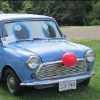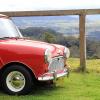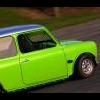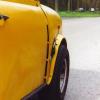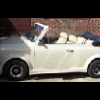My 1968 Mini Traveller had braking problems for much of the summer driving season. I needed to pump the brakes 2 or 3 times before there was good pedal pressure, even though the fluid level in the master cylinder stayed constant. Adjusting and bleeding the brakes did not eliminate the problem, and I was unable to get the left front and left rear wheels to fully lock. I removed all four drums to investigate.
The left rear brake adjusters were worn and small chunks of metal were missing. I plan to replace the adjuster and wedges with http://www.minispare...ic/17H7620.aspx The rear shoes were replaced 12 years ago and have over 4 mm of friction material remaining.
The left front shoes were worn to 1.98 mm and 2.3 mm. The right front shoes were around 2.6 mm. The front pads and wheel cylinders are 14 years old, and two cylinders had a tiny amount of fluid under the boots, and some staining on the backplates. I plan to replace all four wheel cylinders and both sets of shoes.
The Mini Spares parts diagram shows a "front brake shoe retainer spring", which my car never had during my ownership. The part is required with the 0.9375" bore size wheel cylinders (GWC126 / GWC127) which I plan to install. http://www.minispare...ck to catalogue
I have read through the Haynes Manual and the Mini Workshop Manual and can't figure out how the little retainer springs are installed. The photo on the Mini Spares link I posted shows the spring going through a hole in each brake shoe just below the wheel cylinder piston, but the details are obscured by a logo watermark. The photo is attached below for your convenience.
Does anyone have a picture or good diagram they can post showing how the retainer springs are installed?
Thank you,
David Schwartz
Framingham, Massachusetts
Attached Files
Edited by dschwartz1957, 08 November 2024 - 02:52 AM.


